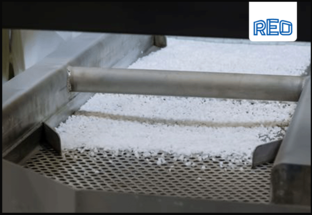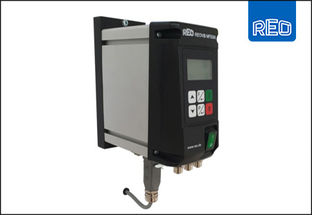OPTIMISE CONVEYOR THROUGHPUT AND REDUCE ENERGY CONSUMPTION
Vibratory feeders are a versatile and efficient way of conveying products and materials in areas like the food and pharmaceuticals industries. However, to maximise the potential of their conveyors, businesses should carefully consider the control devices they use. Here, Steve Hughes, managing director of power quality specialist REO UK, explains how businesses can expand the range of products they can convey, reduce the need for maintenance, and save money in energy costs.
There are two main types of vibratory conveyor: those with mechanical drives and electromagnetic conveyors. Both distribute energy to the conveyor bed through frame-mounted drives and spring arm assemblies, creating a forward vibratory motion, which causes the product to hop along the conveyor.
As the name suggests, mechanical drives, otherwise known as motor driven conveyors, typically use Variable Speed Drives (VSDs) or even Direct-On-Line (DOL), as the control method. VSDs allow speed control, through increased vibration, but the vibration frequency is limited, whereas DOL control applies the full voltage and, in this case, the vibration amplitude and frequency is limited by the mechanical design of the conveyor.
This presents some limitations in use, because some products require certain conditions to convey. In a food processing factory, for example, too intense a vibration can cause flavourings to be shaken off the product, diminishing the quality.
In comparison, electromagnetic feeders use the cyclic energisation of electromagnets, which causes the metal trough to vibrate using magnetic force impulses. This allows for lower amplitude and more flexibility with regards to the vibrating frequency, expanding the range of products they can convey. They also have fewer moving parts, making them much cheaper than motor driven conveyors to maintain.
In both cases, the applications for vibratory conveyors are extremely diverse. They are used in everything from industrial assembly automation to food processing and packaging. Although they are generally more expensive to buy than belt conveyors, they are much easier to maintain and clean because they have smooth stainless-steel troughs instead of belts, pulleys and gears. This allows them to be used in food environments where high levels of hygiene must be maintained.
They also boast other advantages such as sizing, grading, spreading, aligning, elevating and de-watering. For example, when conveying leafy greens in a food processing plant, the vibrations can shake off excess water and soil. This is used to minimise the spread of bacteria.
To unlock the full potential of electromagnetic conveyors, the use of a control device is required. There are different control systems depending on the application of the conveyor. These range from simple controls that use triac or thyristors in the phase control to provide a variable voltage for the magnet, up to frequency converters, that generate any drive frequency and amplitude.
The precise control provided by frequency converters means that vibratory feeders can be set at the required frequencies to convey a wider range of products. It also allows them to be used for many critical applications, like high-speed weighing and counting.
Cutting energy usage
According to Make UK, 42 per cent of the manufacturers surveyed said that their electricity bills had doubled between September 2021 and September 2022. 52 per cent of companies expect their electricity costs to further increase by over 100 per cent over the next year.
Modern control systems are much more energy efficient. As the electromagnetic feeder induces a voltage in the magnet, this can be stored and utilised.
Some devices, such as REO’s MFS368 range of controllers, use an Active Front End, ensuring the input current is in phase with the applied voltage and is not distorted. This allows the product to be conveyed at up to 80 per cent less energy than conventional control systems.
Energy costs are a concern for everyone and food inflation is a function of the raw material, the processing time and energy consumed. When conveyors can be controlled accurately and the feeders used more efficiently, throughput can be optimised.
To get the most out of your conveyor system or to find out about REO’s other power quality solutions, visit www.reo.co.uk or call +44 (0) 158 673 41.














